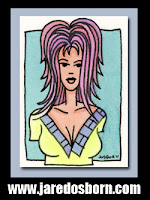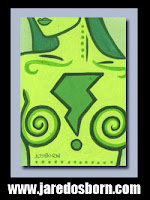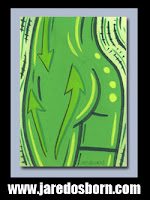
It’s the eternal question of those who have a collection of any kind. What kind of order do you put things in? That’s the difference between a collection and an accumulation. There’s order to a collection and you can find things. People who have accumulations don’t even know what they have or don’t have.
Almost all of my comics are on book shelves. I love shelves because you can get to what’s on them easily. Most collectors use boxes made for storing comics to house their collections. I find this too cumbersome and it makes getting to the comics quite hard. Boxes pile upon boxes and getting to a comic in the bottom box means moving those on top. A lot of effort has to be expended. I build shelves everywhere I can. I have lots of them but I can always use more. I advise everyone to learn how to build shelves and book cases. It’s not hard.
As the guy who invented the Dewey Decimal system could tell you: when it comes to organizing books doing it just alphabetically doesn’t work. New comics are being made (and bought) every week and my collection is constantly expanding. Thus when the finite room of a particular shelf has run out, but there are still new comics to add, the the whole collection has to be shuffled around. That’s if you do things alphabetically.
I solved this problem years ago by putting inactive comic book series (ones that I no longer purchased new issues of) on certain shelves by themselves. This meant that I no longer had to move these ones around. Ever. I was also free to group them alphabetically or by subject or publisher. This approach also includes a computer data base of my comics and their location. But that’s not hard. Computers are real good for that stuff. So if I want to find where the hell my “Omega the Unknowns” are I just enter it and bookcase three shelf four is what I am told. That makes things easy to locate.
Most of my book cases are filled with inactive series. Only three shelves on one bookcase held active series (in alphabetical order). Much less to rearrange as new issues are purchased. That system had held up for years until this week.
The problem was that those three shelves which accounted for my active collections are big. I’d guess there are about 1300 comics in total on those three shelves. That’s a lot of comics and since I haven’t changed my system much in half a decade there were a lot of small inactive series on the shelf. Mini-series, cancelled series, and series I only bought a few issues of. It became impossible to browse those three shelves easily or with any satisfaction.
Browsing a collection is one of the joys of collecting. That’s why it’s important to have some order. Seeing one thing naturally leads you to want to see another that’s some how connected to it. The connection my be emotional, logical, or it may have something to do with buying both things at the same time. Who knows? But if picking up one thing makes you want to see a second thing than that second thing better be easy to find. Or you will soon find yourself frustrated and disinterested. This was my situation with those three shelves.
One of the fun things about comic books is going back and rereading them. This wasn’t happening with those three shelves. So I rearranged them for easiest browsing. Here is the system I came up with.
First I had to weed out the crap. If you follow my “Comics I Bought This Week” posts then you will notice that my tastes are not very mainstream and I am always looking for a new series to try. As a consequence I had about a hundred first, second and maybe third issues stuck on my three shelves. Comics I didn’t like and never bought again. Still I shelved them because no comic collector wants to throw out comics. I pulled them off and maybe I’ll put them on Ebay at 99¢ for all of them. I still don’t want to throw them out. But I might.
A little aside: 99.99% of all comic books are worthless. I know the newspapers like to print articles every now and then on how comics, like the first Superman or Batman, are really expensive but those are the rare exception. I have a lot of comics but none are worth any real money. Hardly any are worth the three dollars an issue I pay for them off the stands. You find this out quickly on Ebay. Most comics are like new cars. They depreciate the moment you drive them off the lot. An eclectic collection like mine would probably only be bought by some comic dealer who buys by the pound. Yes, that’s how many worthless comics there are out there. Unless you can show a dealer specific things to interest him it’s not worth his time to go through a eight or ten thousand book collection. They just weigh it and give you X dollars a pound. X isn’t a high number by the way. And now back to our subject at hand.
Second I needed to create “browsing sections” that made sense to me. I made a “by artist” section. This is a section of stuff that doesn’t read well but has nice art. Some series that I only have a few issues of and they don’t fit in anywhere. For example: George Perez’s “Crimson Plague” only lasted two or three issues and ended in the middle of the story so there is no reason to ever go back and read it but the art is nice. If I want to browse some Perez art there it is in the “by artist” section. Same with thirty other artists.
The next section is the “complete mini-series” section. Each of these is a stand alone compact single story made up of about four to eight issues. When I want a small story I can check out this section.
Then comes the “complete series” section. These are whole runs of small series usually no more than twenty issues or so. The make up a larger canvas than a mini series and are good for when I want to dive into more ambitious concepts.
Lastly comes the “incomplete series” section. These are made up of short series that I am missing an issue or two of. Or maybe a series that was cancelled before it’s time. The section of broken dreams. Browse here at your own risk.
Of course I still have my “active series” section. It’s only three quarters of a shelf long now but at least I can see them at a glance. I did do one thing to make browsing easier. I got some card stock paper and made some dividers that stick out beyond the comics with the name of the comic book series on it. Now I can browse the dividers and know what’s there. They are in alphabetical order of course.
Now if only I had a system for all of my trade paperbacks and hardcovers.




